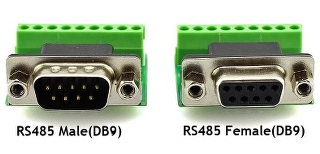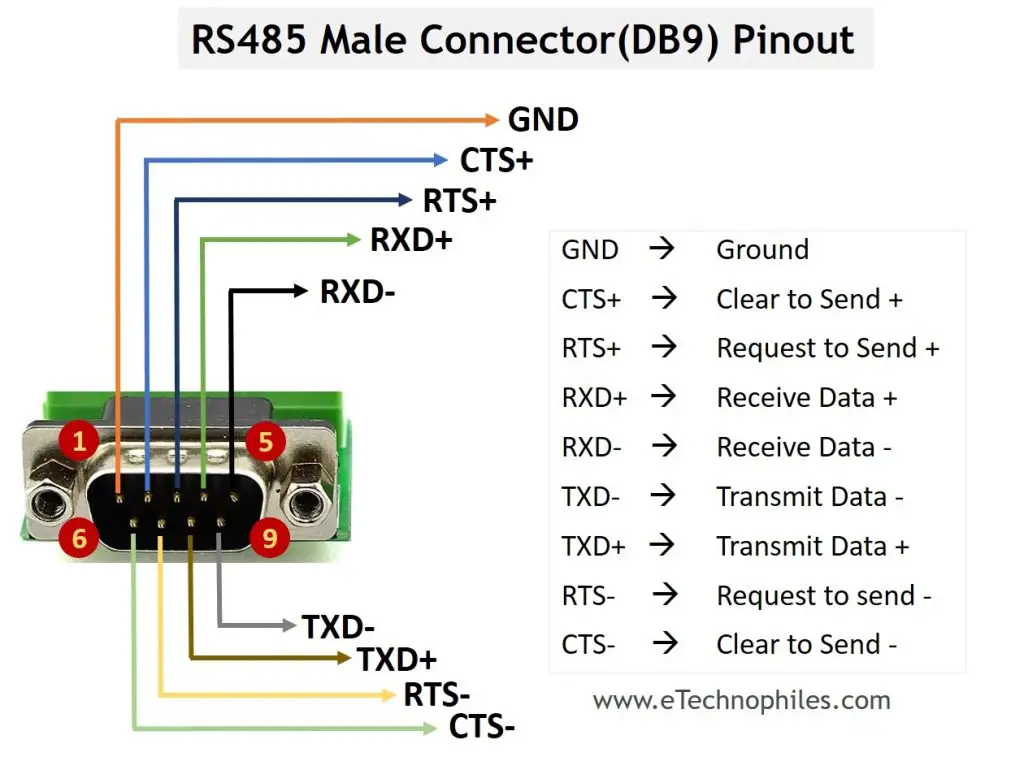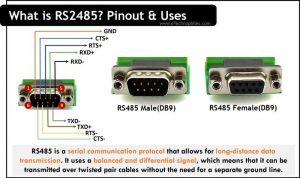Last updated on March 21st, 2024 at 11:47 am
RS485 is a popular standard in serial data communication. It has several advantages and hence it is applied on numerous platforms for effective data transfer. The pinout of RS485 shows that it has a 9-pin DB9 connector.
Table of Contents
What is RS485?
RS485 is a type of serial communication protocol that allows for long-distance data transmission. It is commonly used in industrial and commercial settings where there is a need to connect devices over long distances. RS485 uses a balanced and differential signal, which means that it can be transmitted over twisted pair cables without the need for a separate ground line. This makes it ideal for applications where cable length is an issue.

In addition, RS485 is less susceptible to noise than other types of serial communication protocols, making it ideal for use in noisy environments.
RS485 is primarily a serial communication standard introduced in 1998 by the Electronic Industries Association (EIA). Thus it is also known as TIA485 and EIA485.
Note: The major characteristic of the RS485 standard is that it is a balanced transmission standard. That is, there are two pins each for transmission as well as reception, one for positive and the other for negative. This enables RS485 to create a multi-point transmission line.
An added advantage of RS485 is that it does not demand a specific connector or cable standard. Its DB9 connector is commonly used for RS484. This helps the system designers to be more flexible in their design process. It is a versatile standard in serial communication where even the strips are used as connectors in some cases.
Read also: VGA Pinout, Features, Advantages & Disadvantages
RS485 pinout
RS485 uses the same DB9 connector used in the RS232 protocol. However, the connections to the pins are different since it require positive and negative pins for transmission and reception.

Refer to the table given below for the pinout description.
| No. | Pin Name | Description |
| 1 | GND | Ground |
| 2 | CTS+ | Clear to Send + |
| 3 | RTS+ | Request to Send + |
| 4 | RXD+ | Receive Data + |
| 5 | RXD- | Receive Data – |
| 6 | TXD- | Transmit Data – |
| 7 | TXD+ | Transmit Data + |
| 8 | RTS- | Request to send – |
| 9 | CTS- | Clear to Send – |
Similar article: RS232 Pinout, Definition, Uses, Speed & Baud Rate
12 key advantages of RS485
1. Long-distance communication – RS485 can communicate over much greater distances than other protocols, making it ideal for applications where data needs to be transmitted over long distances. RS485 can have a cable length of up to 1200 meters(data rate is limited to 100kbps), useful for connecting distant devices.
2. High data rates – RS485 can support data rates up to 10 Mbps, making it suitable for applications that require high data throughput.
3. Ease of use – RS485 is a simple protocol to use and doesn’t require special skills or knowledge to set up and use effectively.
4. Reliability – RS485 is a very reliable communication protocol and is often used in mission-critical applications where reliability is paramount.
5. Scalability – RS485 can be easily scaled to support more devices or higher data throughput as needed.
6. Cost-effectiveness – RS485 is typically less expensive(long-distance transmission) than other protocols, making it a cost-effective solution for many applications.
7. Flexibility – RS485 can be used in a wide variety of applications and can be easily adapted to changing needs.
8. Compatibility – RS485 is compatible with a wide range of devices and systems, making it easy to integrate into existing infrastructure.
9. Standards-based – RS485 is a standards-based protocol, which means it is well-documented and easy to find support for.
10. Ruggedness – RS485 is a rugged protocol that can withstand harsh environments and is often used in industrial applications.
11. Multi-point Connectivity- The most celebrated advantage of RS485 is its multi-point connectivity. Apart from a one-to-one connection, RS485 can be used with a serial bus that connects to multiple peripherals. Up to 32 devices can be connected to the communication network of RS485 standard.
12. Noise immunity – Another smart feature of RS485 is that it is immune to electromagnetic interference from motors and welding equipment. Thus it is largely used for the variable control in motors.
Read also: RS232 VS RS485- Know the Difference
What is RS485 used for? applications
The RS485 serial communication standard has a huge set of applications. It is very useful in automation systems as well as to control the variable frequency drivers.
The applications that use RS485 for control are:
- Control motor drivers
- Control of household electrical devices
- Control synchronization of LED displays
- Control lighting in theaters
- Control of video surveillance system
- Control the network layout for model railways with the Digital Command Control standard
Some applications of RS485 are significant in multi-point connectivity. Let’s see some of them.
- The ‘Vehicle Bus’ networks in aircraft connect with several seats at a time.
- Building automation networks where several devices are connected to a single bus.
- To connect multiple devices to Arduino and Raspberry boards.
FAQs
Is RS485 better than RS232?
Yes. RS485 is an advanced version of RS232. It supports multi-point connections and has an improved data rate of 50Mbps. RS485 also comes with a longer cable length of 1200m.
Can we use the same connector for RS484 and RS232?
Yes. RS485 can use the same DB9 connector. However, the signals to pins are different from that of RS232.
Does RS485 work only with DB9 cables?
No. RS484 does not have specific connector cabling standards. We are flexible to use even strips as connectors.
How many devices can we connect with the RS485 standard bus?
RS485 standard supports up to 32 devices in its serial communication network.
Among RS232 and RS485, which is the better option for serial communication in short distances?
The selection of standards highly depends on the required data rate. Both RS232 and RS485 are good for short-distance serial communication. But, RS485 provides a better data rate.
**Read more about RS485 on Wikipedia.
